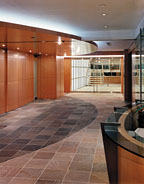

"The site they moved into has an atrium in the center, which creates a very straightforward building plan," Yang said. "We tried to create a space that breaks the long diagonals of what we called the Boulevard -- the main access corridor which runs around the atrium."
To do this, Yang designed distinctive patterns for the flooring. "The flooring on the Boulevard has a square pattern, which was kind of tilted to give it a twist," she said. "The flooring in the main reception area and the elevator lobbies has a round pattern. When a client comes into the building, a circular pattern leads him or her into the space."
Yang specified quartzite tile for these floor patterns. "The original space had wood floors, but they ran into a lot of problems in terms of the maintenance," she said. "We combined some wood flooring with stone tiles, but in the high-traffic areas, stone was used because it would be much more durable and would last longer. Stone was also a good fit with the look we were trying to achieve." The main staircase, which connects all of the floors, also used stone for the treads.
Originally Chinese quartzite was specified, however due to the short amount of time available to complete the project, this quartzite would not make it to the site on time or under budget. So, The Phillips Group turned to Walker Zanger, a stone supplier in Mt. Vernon, NY.
"We suggested quartzite from Brazil," said Jonathan Zanger of Walker Zanger. "Brazil is close enough for the stone to be shipped on time, and Brazilian quartzite has a great range of color. However, the Brazilians are not used to exporting quartzite to the U.S., and since quartzite is normally used for exteriors instead of interiors, it is often ungauged. This quartzite is difficult to calibrate and must be installed in mud rather than thin-set."
Even the dimensions of the stone originally specified had to be altered. "The architects originally wanted 12- x 12-inch tiles, but in order to make it economical and fast, we suggested that they go with the normal size they would have in Brazil," Zanger said. "These larger standard sizes -- approximately 37 x 37 centimeters or 141/2 x 141/2 inches -- are kept in stock."
The Phillips Group ordered two types of quartzite from Brazil -- green and gold. The pieces were uncalibrated and measured 3/8 to 3/4 inch thick in a natural cleft finish. "We brought samples in and did a mock up," Zanger said. "In the gold quartzite, there was a tremendous range in color from white to gold to pink to gray. The green quartzite also had a variation, though less so -- there were some fossilized ferns, gold and rust in it."
According to Zanger, the architects and stone suppliers went to the quarry in Brazil to see what the variation was in fact. "We had them lay out many hundreds of square feet of the tile in stock," he said. "The green was simple -- we selected the portions we needed -- but in the gold, the majority of the material was selected out. We only used about 15% of their stock with a light white-to-gold coloring. We didn't want any pink or gray in it, so a lot was selected out."
The slabs for the stairways were a bit more difficult. "Quartzite is difficult to come by in slabs," Zanger said. "It is usually used for tiles. They had to save the big slabs at the factory so we could make sure the entire slab matched out tile selections. We also had to have the architect redesign the treads to shorten them because we couldn't get slabs big enough."
The clients were quite pleased with the result, and even asked to have a sixth floor added to the plan after they saw how well it was developing.
Credit Box
Credit SuisseNew York, NY
Owner: Credit Suisse Asset Management
Architect:The Phillips Group, New York, NY
Supplier: Walker Zanger, Mt. Vernon, NY
Installer: Navillus Tile, Long Island City, NY